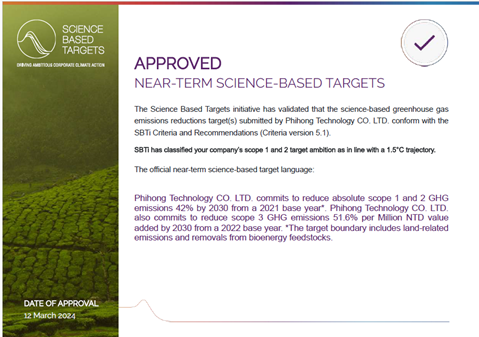n response to climate change risks, Phihong has set a structured carbon reduction path aligned with climate adaptation strategies. In March 2024, Phihong received official target verification from the globally recognized Science Based Targets initiative (SBTi), underscoring its commitment to help limit global temperature rise to within 1.5°C.
Phihong has proactively advanced its ESG management efforts in recent years. In 2021, the company submitted a carbon reduction pledge to SBTi, completed its target submission in November 2023, and received final approval in March 2024. Phihong has committed to reducing absolute greenhouse gas emissions in Scopes 1 and 2 by 42% by 2030, based on a 2021 baseline, and to cutting Scope 3 emissions intensity by 51.6% compared to 2022. Through a comprehensive greenhouse gas inventory, Phihong continuously evaluates its emissions levels, formulates effective reduction strategies, and demonstrates its dedication to achieving net-zero emissions by 2050.
The SBTi, launched by the United Nations Global Compact (UNGC) and the Carbon Disclosure Project (CDP), provides scientifically based guidelines, standards, and third-party-certified reduction recommendations for corporate carbon targets. By the end of 2023, 4,204 companies worldwide had received SBTi target verification, doubling from 2022. More than one-third of the global economy is now represented by companies that have set or committed to science-based carbon reduction targets, actively joining the climate action movement.
Explanation of Greenhouse Gas Scopes:
Scope 1: Direct greenhouse gas emissions from sources owned or controlled by the company.
Scope 2: Indirect emissions from energy procured and consumed internally, typically from electricity and heating.
Scope 3: Other indirect greenhouse gas emissions that occur outside the company’s control, including upstream and downstream production, transportation, raw material procurement, employee business travel, and the carbon footprint of sold products in use.
